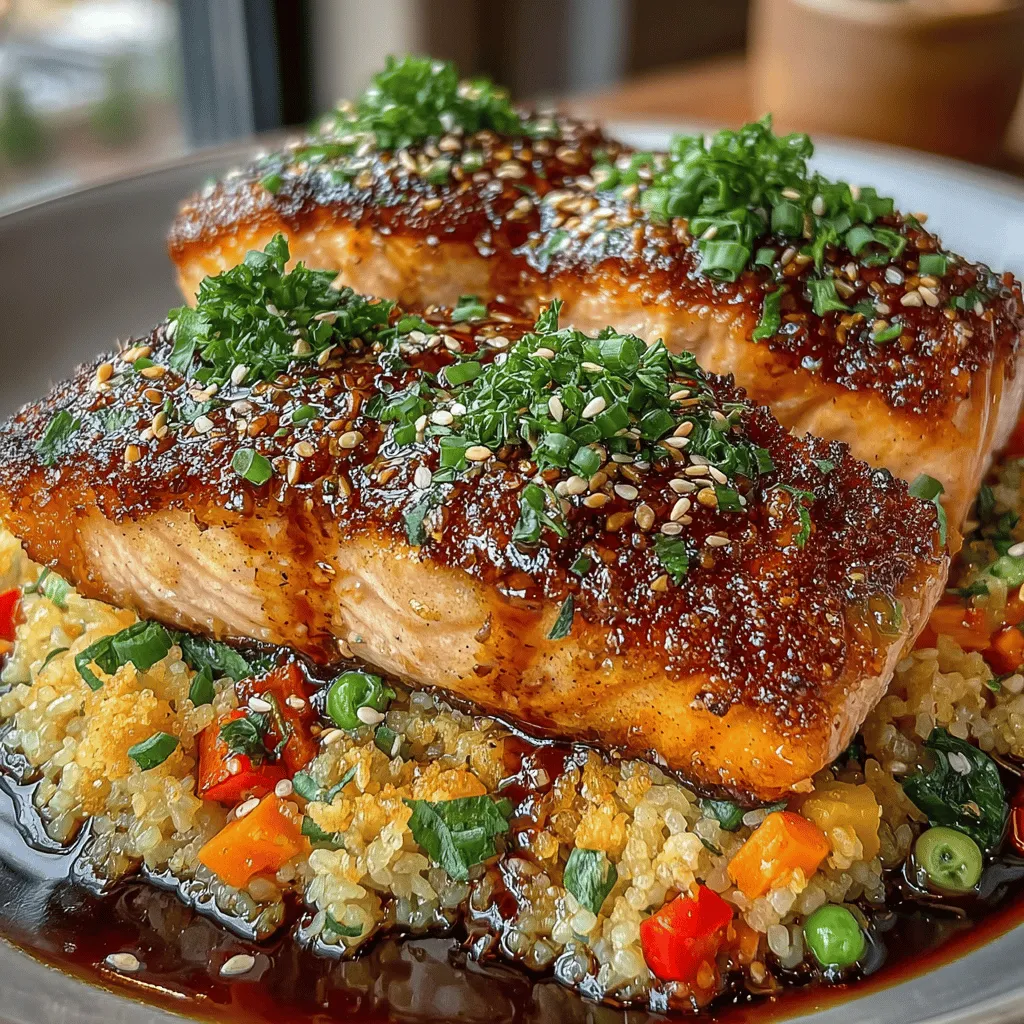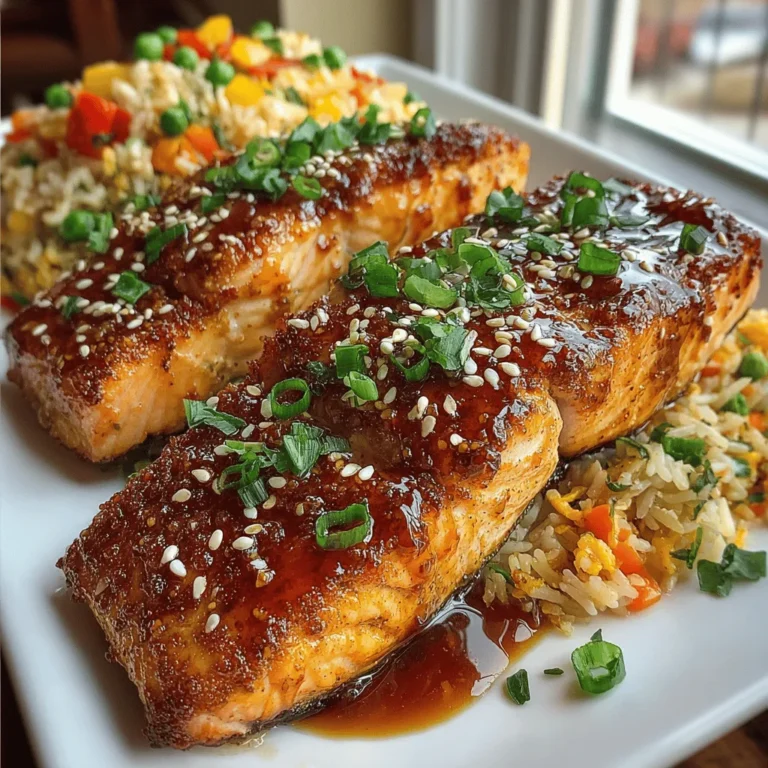Introduction
Teriyaki Salmon with Veggie Rice is a delightful dish that brings together the umami flavors of Japanese cuisine in a wholesome, quick meal option. Whether you’re looking for a weeknight dinner solution or a meal prep idea that satisfies, this dish is a fantastic choice that is both nutritious and easy to prepare. The combination of succulent salmon with a vibrant mix of vegetables over a bed of rice makes for a balanced meal that is not only pleasing to the palate but also visually appealing.
In today’s fast-paced world, the importance of balanced meals cannot be overstated. Homemade teriyaki sauce is a game-changer, allowing you to control the ingredients and ensure you are avoiding preservatives and excessive sugars often found in store-bought alternatives. This recipe offers versatility to cater to various dietary preferences, including gluten-free options, making it a crowd-pleaser for family gatherings or dinner parties.
Understanding Teriyaki: A Brief Culinary History
Teriyaki is a cooking technique that originated in Japan, where it has been a staple for centuries. The term “teriyaki” comes from the Japanese words “teri,” meaning glaze, and “yaki,” meaning to grill or broil. Traditionally, teriyaki sauce is made from a blend of soy sauce, sake, mirin, and sugar, creating a rich, savory flavor profile that enhances grilled meats and fish.
Over the years, teriyaki has evolved, and variations of the sauce can be found across the globe. In addition to the classic soy sauce base, many modern recipes incorporate ingredients such as ginger and garlic for added depth. The global popularity of teriyaki dishes has led to many interpretations, allowing it to fit into various culinary traditions while still honoring its Japanese roots.
Ingredients Breakdown
To prepare this delicious Teriyaki Salmon with Veggie Rice, you will need a selection of fresh, high-quality ingredients that come together to create a harmonious dish.
Salmon
Salmon is the star of this recipe, providing not only a rich flavor but also an abundance of nutritional benefits. Packed with omega-3 fatty acids, protein, and essential vitamins, salmon is an excellent choice for a healthy meal. When selecting salmon, look for cuts that are firm and have a vibrant color, indicating freshness. Wild-caught salmon is often preferred for its superior taste and nutritional profile compared to farmed varieties.
Soy Sauce
Soy sauce is a crucial element in teriyaki sauce, contributing to its savory depth. For those with gluten sensitivities, tamari is a fantastic alternative that provides the same umami flavor without the gluten. When choosing soy sauce, opt for low-sodium versions if you are watching your salt intake.
Honey vs. Maple Syrup
Sweetness is an essential component of teriyaki sauce, and you can use either honey or maple syrup to achieve this. Honey adds a floral note that complements the savory flavors, while maple syrup provides a more robust sweetness with a hint of earthiness. Depending on your dietary preferences or restrictions, both options work well in this recipe.
Fresh Garlic and Ginger
Fresh garlic and ginger are not just flavor enhancers; they also bring significant health benefits to the table. Garlic is known for its immune-boosting properties, while ginger aids digestion and adds a warm spice to the dish. Together, they elevate the flavor profile of the teriyaki sauce and the overall dish.
Sesame Oil
A drizzle of sesame oil adds an aromatic touch to the teriyaki salmon, enhancing the dish’s authenticity. Its nutty flavor complements the other ingredients, creating a well-rounded taste experience. Use toasted sesame oil for added depth, but be cautious with the amount, as it can be quite potent.
Overview of the Veggie Rice Components
The veggie rice serves as a colorful and nutritious base for the teriyaki salmon. Fresh vegetables such as bell peppers, broccoli, and carrots not only provide essential vitamins and minerals but also add texture and visual appeal. Using seasonal vegetables can enhance the freshness of the dish, and feel free to substitute with your favorites or whatever you have on hand.
Rice Choices: Jasmine vs. Basmati
When it comes to rice, the choice between jasmine and basmati can influence the overall flavor and texture of the dish. Jasmine rice is slightly sticky and has a floral aroma, making it a perfect companion for the teriyaki salmon. On the other hand, basmati rice is known for its long grains and nutty flavor, which can also complement the dish beautifully. Choose the type of rice that best suits your taste and dietary preferences.
Step-by-Step Cooking Instructions
With the ingredients at the ready, it’s time to dive into the cooking process. Follow these step-by-step instructions to create your Savory Teriyaki Delight.
1. Prepare the Teriyaki Sauce: In a small saucepan, combine soy sauce (or tamari), honey (or maple syrup), minced garlic, and grated ginger. Bring the mixture to a simmer over medium heat, stirring occasionally until the sauce thickens slightly. This usually takes about 5-7 minutes. Once done, remove from heat and set aside.
2. Cook the Rice: Rinse the rice under cold water until the water runs clear to remove excess starch. In a medium pot, combine the rinsed rice with water (follow the package instructions for water-to-rice ratio). Bring to a boil, then reduce to a simmer, cover, and cook until the rice is tender and the water has been absorbed. This typically takes about 15-20 minutes. Fluff the rice with a fork before serving.
3. Prepare the Vegetables: While the rice is cooking, wash and chop your choice of vegetables into bite-sized pieces. Consider using a mix of bell peppers, broccoli florets, and shredded carrots for a colorful medley.
4. Sauté the Vegetables: In a large skillet or wok, heat a tablespoon of sesame oil over medium-high heat. Add the chopped vegetables and sauté for about 5-7 minutes until they are tender yet crisp. Season with a pinch of salt and pepper to taste.
5. Cook the Salmon: In the same skillet, push the vegetables to one side and add the salmon fillets, skin-side down. Drizzle with a bit more sesame oil and pour half of the prepared teriyaki sauce over the salmon. Cook for about 4-5 minutes on each side, or until the salmon is cooked through and flakes easily with a fork.
This marks the beginning of your culinary journey into the world of Savory Teriyaki Delight. As you progress to the final assembly and presentation, the vibrant colors and rich flavors will undoubtedly impress anyone fortunate enough to share in this meal.

Preparing the Rice
The foundation of any great rice dish lies in how you prepare the rice. Rinsing your rice before cooking is a crucial step that removes excess starch, helping to achieve a fluffy and non-sticky texture. To rinse your rice, simply place it in a fine-mesh sieve or a bowl, cover it with cold water, and swish it around with your hand. Drain and repeat until the water runs clear. This process not only improves the texture but also enhances the overall flavor of your dish.
Cooking Techniques for Fluffy Rice
Once rinsed, it’s time to cook the rice. The method you choose can affect the final result. A common technique is the absorption method, where you combine one part rice to one and a half parts water. Bring the water to a boil, then reduce the heat to low, cover, and simmer for about 18-20 minutes for white rice or 35-40 minutes for brown rice. Avoid lifting the lid during cooking, as this releases steam essential for cooking the rice evenly. Once done, remove it from the heat and let it sit, covered, for another five minutes before fluffing it with a fork. This resting period allows the steam to finish the cooking process and results in perfectly fluffy rice.
Cooking the Vegetables
While the rice is cooking, it’s time to prepare the vegetables. Achieving perfectly sautéed veggies is about timing and technique. Select a mix of colorful vegetables such as bell peppers, broccoli, and snap peas for a visually appealing and nutritious dish.
Tips for Achieving Perfect Sautéed Veggies
1. Uniform Size: Cut your vegetables into similar sizes to ensure even cooking.
2. High Heat: Use medium-high heat to achieve a good sear quickly without overcooking.
3. Oil Choice: Use oils with high smoke points, such as canola or avocado oil, which are great for sautéing.
4. Don’t Crowd the Pan: If cooking a large batch, sauté in batches to avoid steaming the vegetables. This allows them to caramelize and develop a rich flavor.
5. Seasoning: Add salt and pepper at the beginning to enhance the vegetables’ natural sweetness. Consider adding a splash of soy sauce or sesame oil towards the end for added depth.
Making the Teriyaki Sauce
One of the highlights of this dish is the homemade teriyaki sauce. The beauty of making your own sauce lies in its simplicity and the ability to control the flavors.
Emphasizing the Simplicity and Flavor of Homemade Sauces
For a basic teriyaki sauce, you’ll need soy sauce, brown sugar, honey, garlic, and ginger. Combine equal parts soy sauce and sweeteners like brown sugar and honey in a small saucepan. Add minced garlic and ginger to the mix. Bring to a gentle simmer and let it reduce slightly, stirring occasionally, until it thickens into a syrupy consistency, about 5-7 minutes. This homemade version is free from preservatives and additives found in store-bought sauces, allowing you to enjoy a fresher, more authentic flavor.
Cooking the Salmon
Now that your rice, vegetables, and sauce are ready, it’s time to focus on the salmon. Cooking salmon to perfection requires careful attention to both time and temperature.
Techniques for Achieving the Perfect Sear and Cook
1. Preparation: Start by patting the salmon fillets dry with paper towels. This step is crucial for achieving a nice sear. Season both sides with salt and pepper.
2. Hot Pan: Preheat a non-stick or cast-iron skillet over medium-high heat. Add a tablespoon of oil and ensure it’s hot before adding the salmon.
3. Skin Side Down: If your fillet has skin, place it skin-side down first. This helps protect the delicate flesh from overcooking. Cook for about 4-5 minutes without moving it, allowing a crust to form.
4. Flip Carefully: Use a fish spatula to gently flip the salmon and cook for an additional 3-4 minutes, or until it reaches your desired doneness (medium-rare is about 125°F).
5. Glaze with Sauce: In the last minute of cooking, brush the teriyaki sauce over the salmon and allow it to caramelize slightly for an added layer of flavor.
Plating the Dish
The way you present your dish can elevate the dining experience. Here are some creative presentation tips to enhance the visual appeal of your teriyaki salmon with veggie rice:
1. Layering: Start with a base of fluffy rice on the plate, then create a bed of sautéed vegetables on one side. This layering technique adds depth to your presentation.
2. Center the Salmon: Place the teriyaki-glazed salmon fillet on top of the vegetables or slightly off-center. This creates a focal point for the dish.
3. Garnishes: Fresh herbs such as cilantro or green onions can add a burst of color. A sprinkle of sesame seeds can also provide an appealing texture and visual contrast.
4. Drizzle Sauce: Consider drizzling extra teriyaki sauce around the plate or over the salmon for an appetizing touch.
5. Color Contrast: Use colorful ingredients to make the dish pop visually. The combination of bright green vegetables with the rich color of the salmon and the white rice makes for an eye-catching plate.
Nutritional Benefits of Teriyaki Salmon with Veggie Rice
This dish not only tantalizes the taste buds but also packs a nutritional punch.
Overview of the Health Benefits Associated with Salmon
Salmon is renowned for its health benefits, primarily its rich content of omega-3 fatty acids, which are essential for heart health. These fats help reduce inflammation and are beneficial for brain function. Additionally, salmon is a fantastic source of high-quality protein, which is vital for muscle repair and growth.
Nutritional Value of Mixed Vegetables
Incorporating a variety of mixed vegetables brings not only color but also essential vitamins and minerals to your meal. For instance, broccoli is high in vitamin C and fiber, while bell peppers provide antioxidants that support overall health. Eating a rainbow of vegetables ensures a broad spectrum of nutrients.
Combining Protein, Carbohydrates, and Vegetables for a Complete Meal
This dish is a perfect example of a balanced meal. The salmon offers protein and healthy fats, the rice provides complex carbohydrates for energy, and the vegetables deliver essential vitamins and minerals. Together, they create a wholesome, satisfying dish that can support various dietary needs.
Dietary Adaptations
One of the advantages of this teriyaki salmon recipe is its flexibility, allowing for various dietary adaptations.
Gluten-Free Adaptations
For those following a gluten-free diet, it’s simple to adapt this recipe. Ensure the soy sauce is labeled gluten-free or substitute it with tamari, which is a great alternative that maintains the teriyaki flavor profile.
Vegetarian/Vegan Alternatives for the Salmon
If you’re looking for plant-based options, consider using marinated tofu, tempeh, or seitan as substitutes for the salmon. These ingredients can absorb the teriyaki sauce well and provide a satisfying texture.
Low-Carb Variations
For a low-carb version of this dish, swap the traditional rice for cauliflower rice. Simply pulse florets of cauliflower in a food processor until they resemble rice grains, then sauté briefly with a bit of oil until tender. This option reduces carbohydrates while still providing a hearty base for your teriyaki salmon.
Cooking Tips for Success
To ensure your teriyaki salmon with veggie rice turns out perfectly, consider the following cooking tips:
Best Practices for Sourcing Fresh Ingredients
Opt for fresh, high-quality salmon from a trusted source. Look for fillets that are bright in color and have a clean, ocean-like smell. Seasonal vegetables should also be fresh and vibrant, as they will enhance both flavor and nutrition.
Time-Saving Tips for Meal Prep and Cooking
To save time, consider prepping ingredients ahead of time. Chop your vegetables and marinate your salmon in advance. This can allow for a quicker cook time during the week. Using a rice cooker can also streamline the rice cooking process.
Storage Suggestions for Leftovers and Reheating Methods
Leftover teriyaki salmon and veggie rice can be stored in airtight containers in the refrigerator for up to three days. To reheat, use the microwave or a skillet over low heat to prevent the salmon from drying out. For added moisture, drizzle a little water or sauce over the top before reheating.
Conclusion
Savory teriyaki salmon with veggie rice is not only a quick and easy dish to prepare, but it also offers numerous health benefits and versatility that make it an ideal meal for any occasion. From the rich flavors of the homemade teriyaki sauce to the colorful medley of vegetables, this dish is sure to impress family and friends alike.
I encourage you to try your hand at this recipe for a flavorful and nutritious meal at home. Cooking is not just about sustenance; it’s about sharing joy and creating memories with those you love. So gather your ingredients, roll up your sleeves, and enjoy the process of creating this delightful dish!


